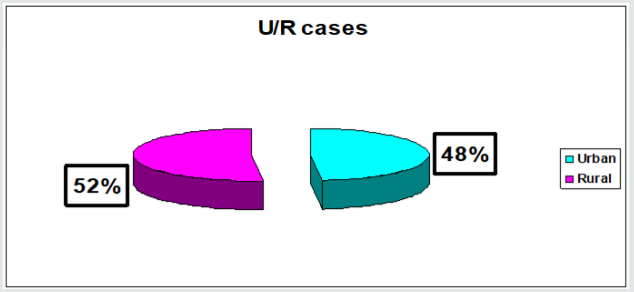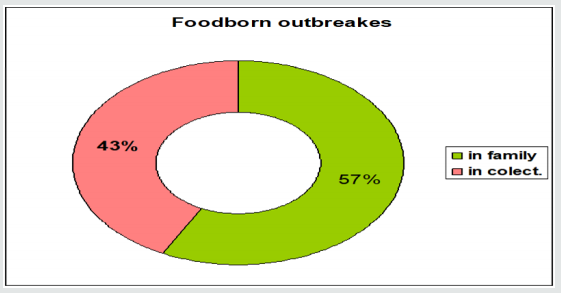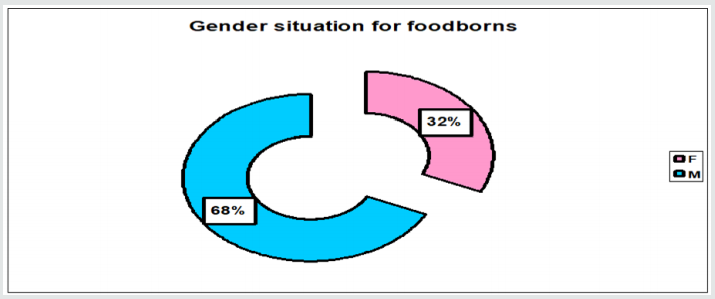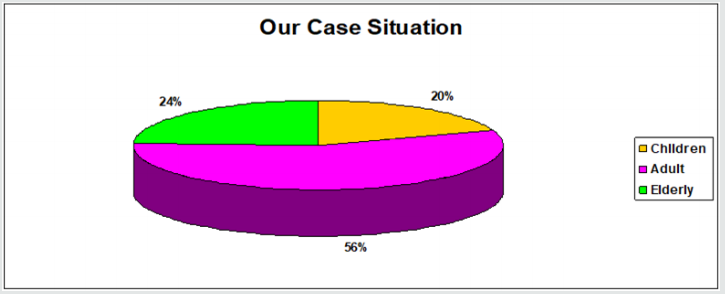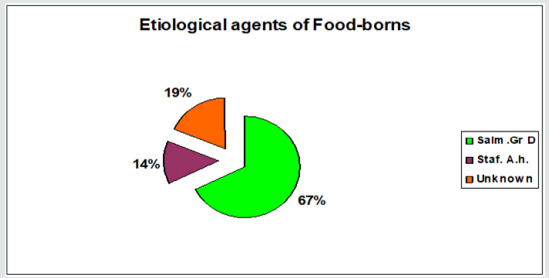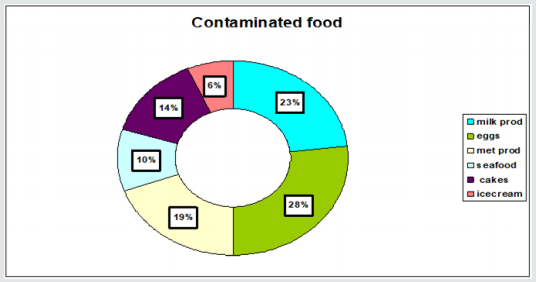
Lupine Publishers Group
Lupine Publishers
Menu
ISSN: 2641-1652
Research Article(ISSN: 2641-1652) 
3 Years Food-Born Illness Study, in Transylvania- Romania Volume 2 - Issue 3
Liana Monica Deac* and Gliga VD
- Public Health Center, Univeristy Babes- Bolyai, Romania
Received:May 07, 2019; Published: May 14, 2019
*Corresponding author:Liana Monica Deac, MD, PhD, First Degree Scientist and Researcher, Senior Epidemiologist, Associate Professor, Public Health Center, Univeristy Babes- Bolyai, Cluj-Napoca, Romania
DOI: 10.32474/CTGH.2019.02.000138
Abstract
Foodborne illness is a common, costly yet preventable public health problem. Every year in the United States, 17 percent of Americans get sick, as a result of consuming contaminated foods or beverages. During the last 3 years 2016-2018, We have observed 183 Food born diseases in our Transylvania region, from Romania, and did a complex epidemiological and clinical study about. On same time, We offer interpretations and conclusions of the cases. Most cases appeared in adults with several chronic illnesses, in 56%, men in 68% from Rural side in 57%. The pathology was relevant in family events, when food contamination occurred probably at any point, from: production, processing, distribution, or any meals preparation with eggs, milk and meat products. There were several clinical forms, from simple one, in 70%, middle one, in 22% to severe who arrived in totality to 8 % and needed almost several days of hospitalization. These food- born infection have had the etiology of bacterial origin, as Salmonella spp. in 67%, Salmonella enteritidis in 29%. In other 14% it was determined Staphylococcus aureus. Unfortunate in 19% forms, we could not put in evidence in our labs any microbiological determinant. To protect people from such diseases, there is needed to survive correct each chain of food production, processing, transportation, handling, and all preparation steps. Most important is to wash well hands during meals preparation.
Keywords: Food- Born; Illness prevention; Contaminated food products
Introduction
Food-borne illness has a large economic impact across the nation, representing millions of dollars in lost income, lost revenue and healthcare-associated costs. It was estimate in CDC studies, that 1 in 6 Americans get sick from contaminated foods or beverages each year, and 3,000 die. Anyone in this world, can get sick from eating contaminated food [1]. That for, WHO publishes annual summaries of domestic food borne disease outbreaks, based on reports provided by state, local, and territorial health departments [2]. These summaries help public health practitioners better understand the: germs, foods, settings, and contributing factors, involved in these outbreaks. They also can help identify emerging food borne disease threats and even can present what can be used to shape and assess outbreak prevention measures. The food we eat and the beverages we drink (including water), can become contaminated by bacteria, viruses, parasites, toxins or chemicals that can cause food-borne disease or food poisoning, which current is most readily to the type of illnesses caused by toxins that may be in the food we eat. A case definition includes criteria for: person, place, time, and clinical features.
Material and Methods
During the last 3 years of time, 2016-2018, the pathology of Food-born diseases in Transylvania region from Romania, have interest us. We got the data about discovered 183 such clinical diseases. From all We got it was a good reason, to determine a complex epidemiological and clinical study, even with some pertinent interpretations and conclusions, for preventions and survey.
Results and Discussions
The accumulate, 183 Food born illnesses took our interest for reasonable medical interpretations. Most of them appeared during the 3 years in the summer seasons, from May to September, in 11-18% (Figure 1). It was obvious that, most cases were in July, but We have had in each month some few case presences. There was an increase of the pathology in 2018, during the last 2 weeks from August to 18%, a month with special high temperatures at us then [3]. When a food borne disease outbreak is detected, public health and regulatory officials work quickly, to collect as much information as possible, to find out what is causing it, so they can act to prevent more people from getting sick. A contamination can happen anywhere along the chain of food production, processing, transportation, handling, and preparation. If contaminated food stays on store shelves, in restaurant kitchens, or in-home pantries, more people may get sick [4]. An outbreak is over when the number of new illnesses drops back to what investigators normally expect.
In our situations, it is interesting to show out that: food contamination occurred at any point, during production, processing, distribution, or preparation; Some foods were contaminated before they reached in the kitchen, even by the food handlers. More it was observed, if contaminated food stayed on store shelves, in restaurant kitchens, or in-home pantries, more people became sick. That for outbreaks can occur in Urban and in Rural places, anywhere. Most in the mentioned period were in our Rural places, where hygiene prescriptions were not very well or right respected in the meal’s preparation (Figure 2). Food-born can be present also in family, or in collectivity situations. We have had most outbreaks in family situation, where some sanitary orders for preparing several foods prepares, were not correct used, as even the choose for the meal’s products, were not well enough and clean selected (Figure 3). Gender has almost nothing to do with food-born diseases, because it can in general happen either at men or female. In our cases, more men 68% have had the disease as female 32% (Figure 4). A simple explanation of the fact can be even that men comes more often to parties or entertaining places as female in our region. CDC report the risk for food-born diseases for: elderly people; children younger than 5 years; people with weakened immune systems; pregnant women who were 10 times more likely to get such infection [1]. Most such disease appeared in our region, in adults with several chronic illnesses, in 56%, followed by the elderly one and children in lower percent’s each, 24% and 20% (Figure 5). The reality for us was that not many children or elderly people, could participate too often, during the 3 years of observation, to many festive meals in restaurants, as even at special family events.
The common symptoms of food borne disease are nausea, vomiting, stomach cramps, diarrhea and sometimes fever. However, symptoms were different among the types of food borne illness, which were simple one in 70%, middle one in 22% and severe forms who arrived to 8 % and needed almost several days of hospitalization in 5%, as even became emergency cases in 3% (Figure 6). No death cases have been reported in our 3 years study. Typically, food-borne disease only lasts a few days. It depends almost even of the Microbiological origin of the food infection. The top five germs that cause illnesses from food eaten, in the United States are: Norovirus, Salmonella, Clostridium perfringens, Campylobacter and Staphylococcus aureus [5]. Most their toxins may be in the food we eat. These toxins may be produced by: bacteria growing on food that has not been handled properly; may result from chemicals, heavy metals and other substances in food; or because of fish, shellfish or other animals which have concentrated toxins in their flesh from their feeding habits and environment [6]. At present in Romania We can still have, food- born infection almost with: Salmonella, Campylobacter, Staphylococcus aureus and suddenly with Norovirus and Clostridium perfringens. In our cases from the mentioned region, the etiology was because of: Salmonella spp. 67%, mostly Salmonella enteritidis 29 %. 14% of the food-born diseases were determined by Staphylococcus aureus and in 19% forms, we could not put in evidence any microbiological determinant (Figure 7). Many pathogens harmful to humans exist naturally in much of the food we eat, such as meat and poultry. Usually, these pathogens are destroyed when the food is cooked. However, if the food is eaten undercooked or raw, or the food is handled improperly during preparation or storage, the risk for transmitting pathogens to humans increases. Eggs in 28%, contaminated milk in 23% and meat products in 19% caused most of the food-born in our regions. In rest other cases have been caused by seafood in 10%, cakes in 14 %, or ice-cream in 6% (Figure 8).
Conclusion
1. To prevent Food-born disease there is necessary to wash your hands and surfaces as often possible.
2. To protect people from such disease there is needed to survive correct each chain of food production, processing, transportation, handling, and all preparation steps.
3. The population must be educated for good Hygiene uses which is a grateful prevention of these illnesses.
4. Correct hand washing before to prepare meals, can decrease the number of the diseases.
A useful prevent and control activity in Food born infection, is to be put together: Epidemiologists, environmental health specialists, laboratory specialists, clinicians as all other specialists with possible enteric disease outbreak connections and therapy responsibilities.
References
- Centers for Disease Control and Prevention (2010) Surveillance for foodborne disease outbreaks - United States, 2007. Morbidity and Mortality Weekly Report 59: 973-979.
- World Health Organization (2008) WHO initiative to estimate the global burden of foodborne diseases. A summary documents.
- Codex Committee on Food Hygiene (CCFH). European Commission 2015.
- Tirado C, Schmidt K (2001) WHO surveillance programmes for control of foodborne infections and intoxications: preliminary results and trends across greater Europe. J Infect 43: 80-84.
- DSouza RM, Becker NG, Hall G, Moodie KB (2004) Does ambient temperature affect foodborne disease. Epidemiology 15: 86-92.
- Scallan E, Griffin PM, Angulo FJ, Tauxe RV, Hoekstra RM (2011) Foodborne illness acquired in the United States unspecified agents. Emerging Infectious Diseases 17: 16-22.

Top Editors
-

Mark E Smith
Bio chemistry
University of Texas Medical Branch, USA -

Lawrence A Presley
Department of Criminal Justice
Liberty University, USA -

Thomas W Miller
Department of Psychiatry
University of Kentucky, USA -

Gjumrakch Aliev
Department of Medicine
Gally International Biomedical Research & Consulting LLC, USA -

Christopher Bryant
Department of Urbanisation and Agricultural
Montreal university, USA -

Robert William Frare
Oral & Maxillofacial Pathology
New York University, USA -

Rudolph Modesto Navari
Gastroenterology and Hepatology
University of Alabama, UK -

Andrew Hague
Department of Medicine
Universities of Bradford, UK -

George Gregory Buttigieg
Maltese College of Obstetrics and Gynaecology, Europe -

Chen-Hsiung Yeh
Oncology
Circulogene Theranostics, England -
.png)
Emilio Bucio-Carrillo
Radiation Chemistry
National University of Mexico, USA -
.jpg)
Casey J Grenier
Analytical Chemistry
Wentworth Institute of Technology, USA -
Hany Atalah
Minimally Invasive Surgery
Mercer University school of Medicine, USA -

Abu-Hussein Muhamad
Pediatric Dentistry
University of Athens , Greece

The annual scholar awards from Lupine Publishers honor a selected number Read More...



